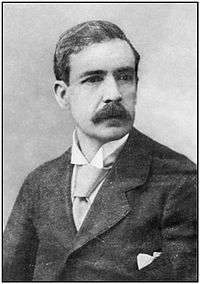William Niven
| William Niven | |
|---|---|
|
William Niven, mineralogist, circa 1895 | |
| Born |
6 October 1850 Bellshill, Lanarkshire, Scotland |
| Died |
2 June 1937 (aged 86) Austin, Texas, United States |
| Residence | Scotland, United States |
| Fields | Mineralogy, archeology |
| Known for | Mineral discoveries; "Niven tablets" |
William Niven (2 October 1850 – 2 June 1937) was a mineralogist and archeologist noted for his discovery of the minerals yttrialite, thorogummite, aguilarite and nivenite (named after him), as well as a set of controversial tablets. Originally from Scotland, Niven came to the United States in 1879, where he became heavily involved in mineralogy and mining.
Mineral discoveries
Niven's first major contribution to mineralogy occurred in 1889 while he was on an expedition to Llano County, Texas, on behalf of Thomas Edison. Niven was looking for the mineral gadolinite, which was used as a street lamp filament. It was on this expedition that he discovered three new minerals, yttrialite, thorogummite, and nivenite.
In the 1890s, Niven discovered the mineral aguilarite while on an exploration trip to Mexico. He also found new deposits of rare minerals in New York and New Jersey.
In Mexico
Niven eventually became interested in archaeology through his travels to Mexico and excavations being undertaken there at the time. Niven began his archaeological work in Guerrero, Mexico where, among of other work, he purchased the first rediscovered Xochipala-style figurine. Due to the Mexican Revolution of 1910, however, he was forced to move to the Valley of Mexico.
The "Niven tablets"
The year 1921 brought the first discovery of one of the andesite tablets. The indecipherable markings on these tablets were the subject of much controversy over the last years of Niven's life.
The so-called Niven tablets are and have been surrounded by controversy since their discovery by Niven in 1921. They have been associated with Scandinavian petroglyphs as posited by Ludovic Mann and they have also been associated with lost continent theories. Their association with lost continent theories comes through James Churchward's interpretation of the symbols found on the tablets.
James Churchward and the lost continent of Mu
James Churchward offered an interpretation of the tablets that caused less belief in their authenticity. Churchward was a major proponent of theories regarding lost continents, specifically the continent of Mu, a continent often mentioned in esoteric texts of various cultures around the world. He believed that early in the history of the world there existed a continent which was called Mu. This civilization, according to Churchward and many others, was very technologically advanced but was destroyed due to natural disaster. After viewing rubbings of Niven's tablets Churchward strongly believed that there were a group of people that escaped destruction and migrated to other parts of the world spreading their culture and belief system. He believed that the symbols and markings found on the tablets had roots in the ancient culture of Mu. This furthered speculation that the tablets were a hoax.
The end of the tablets
Niven spent the good part of his life selling the tablets and trying to find out their origin and meaning. This was never accomplished. The tablets were interpreted by many people and many theories were posited, but to no avail. They were eventually lost during the latter part of Niven's life, during their attempted shipment from Mexico to the U.S. The only remaining evidence is the rubbings that were taken from the actual tablets.
In fiction
Niven is the basis for the character William Givens in Katherine Anne Porter's short story Maria Concepcion.[1]
References
- ↑ Wicks, Robert S. and Harrison, Roland H. (1999). Buried Cities, Forgotten Gods: William Niven's Life of Discovery and Revolution in Mexico and the American Southwest, Texas Tech University Press. ISBN 0-89672-414-X
- Handbook of Texas Online: William Niven. The Texas State Historical Association. Retrieved on 2007-01-07;
- Lossing, Benson John (1915) "Niven, William (1850- )" Harper's Encyclopaedia of United States History: From 458 A.D. to 1915 (New edition entirely revised and enlarged in 10 volumes) Harper & Brothers Publishers, New York;
External links
- Wilson, Wendell E. (2006) "William Niven" The Mineralogical Record - Label Archive
- Works by or about William Niven in libraries (WorldCat catalog)
- "Archaeological Fantasies Podcast Episode 24: Jeb Card and the Mu Stones (Niven Tablets)". 2015-11-23. - Podcast discussing the recent rediscovery of 11 of the Niven Tablets (Called Mu Stones in the episode) in museums in the United States.
